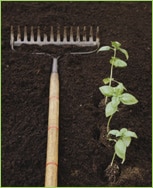Grass Planting Tips
When:
For spring-time seedings, plant anytime up to early May. Mid-April is an ideal time, and an oat-hay nurse crop could be included in the seed mix. Late summer and fall seeding is acceptable starting in about mid-August, (or early winter in southern climates) after the peak summer heat through about mid-September. Allow enough fall growing time for the development of an adequate root system in the new grasses.
Fertilize:
As with dry-land seeding, don’t apply fertilizers (or herbicides) to new grass seedlings until the grasses are in the three to five leaf stage. Consult a qualified professional for fertilizer recommendations. Also, most grass seedings don’t require fertilizer prior to establishment. Often applying fertilizer at planting only encourages unwanted weed competition. Wait until the grasses have established themselves, soil test and then fertilize according to recommendations.
Method:
Use either a drop or a cyclone seeder to seed your area. A drop seeder is more accurate in placing seed, especially if the wind is a problem. However, if the ground is rough or rocky, the cyclone seeder will be easier to use. Seed at the rates recommended for your grass mix. (up to 5 pounds per 1000 square feet) Divide seed into two equal parts. Sow half of the seed by crossing the area north to south and the other half by crossing east to west. Rake the seed into the soil as soon as possible after sowing to reduce the chances of it blowing or washing out. Soil cover also helps to protect the young seedlings from drying out. When sowing on slopes prone to erosion, cover the seeded area with a thin layer of mulch. Recommended mulches include clean straw (straw with no seeds in it), netting or single-layer matting of some kind.
Water:
If you have water from a central community system or a water well permit that allows outside irrigation, water the newly seeded areas frequently and lightly. Water enough to keep the soil moist but not so heavily as to cause soil washing and loss of the grass seed.
—————————————————————————————————-
Extracted From: Colorado State University Extension. 8/99. Reviewed 1/08. www.ext.colostate.edu
Here is some more information about Warm Season vs. Cool Season Grasses
Thanks to:https://www.thomasrainer.com/
Horticulturists divide true grasses into two general categories that describe their growth cycle through a year: cool season and warm season grasses. Cool-season grasses start their growth early in spring and continue that growth while cool temperatures and rain prevail. When summer gets hot, these grasses typically go dormant, often “browning out.” Some cool-season grasses even die back in the summer, leaving seeds to germinate during the next cool season. If you’ve ever seen your lawn covered in Annual Bluegrass (Poa annua) in May only to see it disappear by June, it’s because this is an evolutionary strategy devised by this cool season grass. Cool-season grasses are best planted/seeded in early spring or late summer/early fall. They tend to germinate and establish quickly. Cool season grasses foliage color looks best during late spring and early summer.
Warm-season grasses, on the other hand, focus their energy on establishing deep roots during their first and second year of life, and then growing during their second and third year. Warm-season grasses are slow to establish, often frustrating gardeners during their first year. This is especially true when seeding a meadow—weeds and other aggressive plants can take hold while WSG establish. These grasses are best planted in late spring. Fall planting is not recommended unless you plant them as plugs, quarts, or gallons before mid-September. If you seed warm-season grasses in the fall, they will stay dormant and emerge in the spring. Warm-season grasses also tend to stay low during the cooler parts of summer, and wait till the heat of summer to put on their full height.
Cool Season Grasses:
Briza media, Bromus spp., Calamagrostis x acutiflora ‘Karl Foerster’, Calamagrostis canadensis Chasmanthium latifolium, Deschampsia caespitosa, Deschampsia flexuosa, Elymus spp., All Fescues, Helictotron sempervirens, Koeleria spp, Melica altissima and ciliata, Molinia, Nasella tenuissima, Sesleria spp., Stipa spp.
Warm Season Grasses:
Andropogon spp, Bouteloua spp, Buchloe, Calamagrostis brachytricha, Eragrostis spp, Hakonechloa spp, Miscanthus spp, Muhlenbergia spp, Panicum spp, Pennisetum spp. Sporobolus heterolepsis, Schizachyrium spp, Sorghastrum nutans

